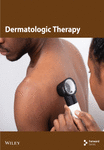Pilot Study on the Efficacy of a Dual-Length Microneedle Radiofrequency Device With Microblade Design for Neck Rejuvenation
Abstract
Background: Neck aging presents challenges in achieving satisfactory cosmetic outcomes, particularly horizontal wrinkles. Minimally invasive technologies like microneedle radiofrequency (RF) devices offer promise for neck rejuvenation.
Aim: This study evaluates the efficacy and safety of the novel microblade RF device for nonsurgical neck rejuvenation.
Methods: Twelve healthy Korean volunteers received two microblade RF treatment sessions spaced 4 weeks apart. Skin biophysical properties were measured at baseline, Week 4, and Week 12. Assessments included Horizontal Neck Wrinkle Severity (HNWS) scores, Global Aesthetic Improvement Scale (GAIS) scores, and safety outcomes.
Results: Significant reductions in HNWS scores were observed over time (p < 0.001), alongside improved GAIS scores. Skin hydration increased, transepidermal water loss decreased, and skin elasticity improved at weeks 4 and 12. Treatment-related adverse effects were mild-to-moderate and transient, with no serious side effects reported.
Conclusion: The microblade RF device demonstrates efficacy and safety for nonsurgical neck rejuvenation, with improvements in horizontal wrinkles and skin properties over time. These findings highlight its potential as a valuable tool in neck rejuvenation procedures.
1. Introduction
Aged skin displays various signs of aging, including increased wrinkles, skin laxity, and loss of elasticity [1]. In contrast to the typical wrinkles and rhytides observed on the aged face, aging of the neck is primarily characterized by horizontal wrinkles, manifesting as linear grooves or furrows on the anterolateral sides of the neck [2]. This appearance is often referred to as the telltale sign of aging, as rejuvenating the neck region presents unique challenges in achieving satisfactory cosmetic outcomes [3]. Therefore, the pursuit of noninvasive yet effective methods for neck rejuvenation has long been a focus within the field of esthetic medicine. While surgical interventions have historically been the primary approach for addressing neck laxity and skin aging, the emergence of minimally invasive technologies has revolutionized the landscape of esthetic procedures. Current noninvasive and minimally invasive treatments for neck laxity include laser therapy, chemical peeling, botulinum toxin, and fillers [4–6]. While effective, these approaches have limitations such as temporary results, uneven skin tightening, and potential adverse effects.
Among these innovations, microneedle radiofrequency (RF) devices have gained significant attention for their ability to deliver precise and controlled energy to targeted layers of the dermis [7]. By combining the principles of microneedling with RF energy, these devices offer a versatile solution for stimulating collagen production, tightening lax skin, and improving overall texture and tone. The use of insulated microneedles allows for selective heating of dermal tissue while minimizing damage to the epidermis, thereby enhancing safety profiles and reducing downtime compared to traditional ablative procedures.
Recently, a novel microblade RF device has been developed, featuring dual-length needles designed to intensify respective effects on the papillary and reticular dermis [8]. While microneedle RF technologies have demonstrated efficacy in skin rejuvenation, their penetration and energy distribution remain suboptimal for treating horizontal neck wrinkles. The variation in the shape of the microblade, resembling a hexagonal column, was specifically designed to enhance tissue regeneration and biostimulation, facilitate improved energy delivery and tissue penetration, and optimize outcomes by precisely targeting specific dermal layers, addressing the limitations of conventional microneedle RF treatments.
In this study, we performed a novel microblade RF procedure using the microblade RF device on aged neck skin. Our objective was to evaluate the outcomes of this device for nonsurgical neck rejuvenation.
2. Materials and Methods
2.1. Ethics Approval
This prospective cohort study received approval from the Institutional Review Board of Chung-Ang University Hospital (IRB no. 2207-005-513) and adhered to the guidelines of the Declaration of Helsinki. All patients provided informed consent before participating in the study.
2.2. Subjects
The study was conducted at Chung-Ang University Hospital, Seoul, Korea, and included 12 healthy Korean volunteers aged 19 and older seeking cosmetic improvement for neck wrinkles. Participant recruitment occurred between March and May 2023, with follow-up assessments conducted through August 2023. A sample size of 12 was chosen based on prior exploratory studies in skin rejuvenation, allowing for preliminary efficacy and safety assessments before larger-scale trials [9, 10]. Individuals who had undergone cosmetic treatments for neck skin in the past 2 months, such as topical agents, oral medications, laser treatments, and peels, as well as those who had received RF treatments on their neck skin within the last 6 months, were excluded.
2.3. Treatment
The novel microblade RF device (DoubleTite, AGNES MEDICAL Co., Ltd, Gyeonggi-do, Republic of Korea) was utilized in this study. Subjects underwent two treatment sessions spaced 4 weeks apart. Prior to treatment, a topical anesthetic cream, EMLA (Astra Pharmaceuticals, L.P., Wayne, Pennsylvania), a eutectic mixture of lidocaine and prilocaine, was applied for 30 min to the entire anterolateral part of the neck. After cleansing with chlorhexidine, each subject underwent the procedure.
The device generates 1-MHz RF energy. The handpiece tip contains a bundle of disposable microblades consisting of five long (1000 μm) and eight short (400 μm) microneedles. Along with precise tissue coagulation via RF, the sterilized tips of the long microblades enable controlled injection of predetermined proportions and volumes of medication into the skin—five long hollow needles have both RF and injection functions simultaneously, while short solid microblades only perform RF.
A 1.5-mL solution of the soft cross-linked hyaluronic acid filler (Elravie Balance, Humedix, Anyang, Korea) was used for injection. In the clinical application of the microblade RF with the Elravie Balance HA filler, the following settings were used: Power level 8 W and duration 100 ms. The ejaculated volume per cycle spans from 8 to 10 μL. The filler contained HA at a concentration of 20.0 and 3.2 mg/mL lidocaine [11]. All procedures were performed by the same investigator to ensure consistency and reduce variability.
2.4. Assessment
Subjects returned for follow-up (Visit 3) 3 months after their second treatment. During each visit, a dermatologist conducted a comprehensive assessment of the facial skin of all participants. The overall improvement in facial skin aging was evaluated using the Global Aesthetic Improvement Scale (GAIS). Two independent dermatologists, blinded to treatment timing, determined the GAIS score and assigned a number on a five-point grading scale based on the level of improvement (grade 1 = worsened, 2 = unchanged, 3 = improved, 4 = much improved, and 5 = very much improved). Interrater reliability for GAIS scoring was assessed using Cohen’s kappa coefficient, yielding a score of 0.82, indicating strong agreement. Patients also self-evaluated their level of improvement in the GAIS score.
The Horizontal Neck Wrinkle Severity Scale (HNWS) was used to evaluate the efficacy in improving the severity of necklines (grade 0 = absent to minimal wrinkles, 1 = mild/shallow but visible wrinkles, 2 = moderate/moderately deep wrinkles, 3 = severe/deep wrinkles, and 4 = very severe/very deep wrinkles with or without furrows; adjacent skin may appear as folds) [12].
Measurements of transepidermal water loss (TEWL) (Tewameter, TM300, Courage-Khazaka electronic GmbH, Köln, Germany), skin hydration (Corneometer, CM825, Courage-Khazaka electronic GmbH, Köln, Germany), and skin elasticity (Cutometer, MPA580, Courage-Khazaka electronic GmbH, Köln, Germany) were taken at baseline, Week 4, and Week 12. A decrease in TEWL and an increase in corneometry indicated improvement in the skin barrier function and the moisturizing effect. The average of five repeated measurements was used as evaluation data. Skin elasticity measured by Cutometer is calculated with the indices of R2, R5, and R7. R2 represents viscoelasticity, the resistance to the mechanical force versus the ability of returning, while R5 indicates net elasticity, the elastic portion of the suction part versus the elastic portion of the relaxation part, and R7 correlates the portion of the elasticity compared to the complete curve.
Participants were encouraged to report any discomfort or adverse events, such as erythema, edema, or bruising, experienced during and after the procedure. Physical examinations were conducted for safety monitoring.
2.5. Statistical Analysis
R language version 4.2.2 (R Foundation for Statistical Computing, Vienna, Austria) and TnF program ver. 4.0 (YooJin BioSoft, Korea) were used for all statistical analyses. Continuous variables were presented as the median (interquartile range), and categorical variables were presented as the sample number and percentage. Normality was assessed using the Shapiro–Wilk test before applying the Wilcoxon signed-rank test. The Wilcoxon signed-rank test was used to compare measurement changes of continuous variables at 4 weeks and 12 weeks compared with baseline (Week 0). For multiple test corrections, the Bonferroni method was performed. Linear mixed-effect model analysis was conducted to analyze the fixed time effect for each measurement. A significance level of a p value < 0.05 was used for all statistical analyses.
3. Results
3.1. Subjects and Efficacy Outcomes
All 12 participants (11 female and 1 male) completed the study without dropouts and were included in the final analysis (Table 1). The mean age was 61 ± 9.19 years (range: 51.8–68.8 years). While confounders were not formally adjusted for, factors such as participant age, gender, and baseline skin condition were considered in the study design, recognizing that middle-aged and older women are primarily seeking demographic treatment for neck wrinkles. The mean HNWS score at baseline was 2.58 ± 0.49 (range: 2–3), indicating moderate to severe, deeply etched neck wrinkles. By Visit 2, which occurred 4 weeks after the initial treatment session, the HNWS score decreased to 1.58 ± 0.49. By Week 12, it further decreased to 1.33 ± 0.62.
| Age (years) | 61 (8.8) |
| Gender (female) | 11 (91.7%) |
| Corneometer | 68.3 (13.6) |
| TEWL | 15.6 (7.5) |
| R2 value | 63.2 (11.6) |
| Horizontal neck wrinkle scale | |
| Grade 2 | 5 |
| Grade 3 | 7 |
| Fitzpatrick skin type | |
| 3 | 7 |
| 4 | 5 |
- Note: Data are means (SD) or numbers (%).
The regression coefficient, with 95% confidence intervals, for the time effect in the linear mixed-effect model on the HNWS score was −0.625 (−0.757 to −0.493) (Table 2). A coefficient > 0 indicates an increase over time for the respective variable, while a coefficient < 0 signifies a decrease. The p value was < 0.001, indicating a significant improvement in horizontal neck wrinkles over time. The representative case is shown in Figure 1.
| Index | Coefficient (95% CI) | p value |
|---|---|---|
| Corneometer | 9.047 (5.491∼12.603) | < 0.001 |
| Tewameter | −3.498 (−4.528∼−2.467) | < 0.001 |
| Cutometer R2 | 10.258 (6.872∼13.645) | < 0.001 |
| Cutometer R5 | 14.100 (11.456∼16.744) | < 0.001 |
| Cutometer R7 | 11.642 (9.657∼13.626) | < 0.001 |
| Horizontal neck wrinkle scale | −0.625 (−0.757∼−0.493) | < 0.001 |
- Note: Coefficient (95% CI): regression coefficient and 95% confidence intervals for the time effect in the linear mixed effect model. A coefficient > 0 indicates an increase over sessions for the respective variable, while a coefficient < 0 signifies a decrease.
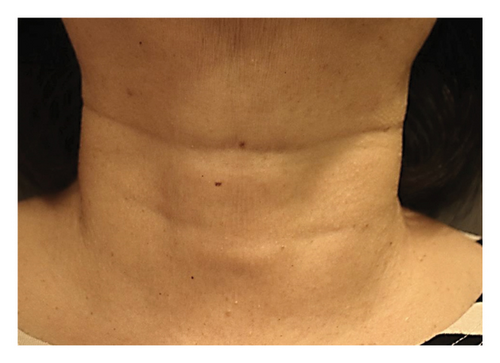
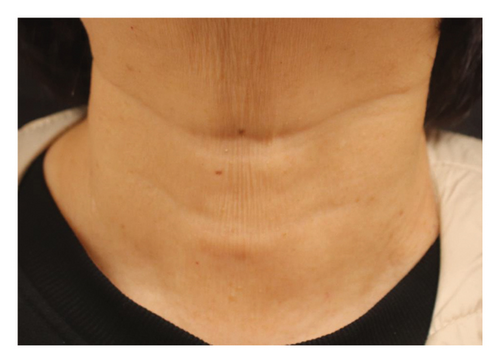
Both dermatologist-reported GAIS and patient-reported GAIS indicated better improvement at Visit 3 compared to Visit 2. For dermatologist-reported GAIS, the scores were 2.83 ± 0.37 at Visit 2 and 2.08 ± 0.64 at Visit 3, reported as improved to much improved. Similarly, for patient-reported GAIS, there was greater improvement at Visit 3 (2.67 ± 0.47) compared to Visit 2 (3 ± 0) (Figure 2).
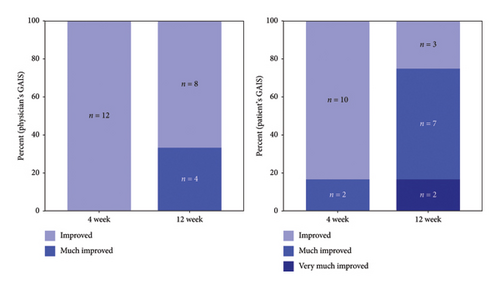
Significant improvements were observed in the objective measurement of skin biophysical properties following the procedure, as obtained by the corneometer, tewameter, and Cutometer. Skin hydration increased at both Week 4 and Week 12, while TEWL decreased, indicating improved skin barrier function. Additionally, the skin elasticity indices, as determined by R2, R5, and R7 values measured by the Cutometer, showed consistent improvement at Week 4 and Week 12 (Table 3, Figure 3).
| Variable | Reference | Comparison | Comparison—reference | p value |
|---|---|---|---|---|
| Corneometer | 0 week | 4 weeks | 8.65 (1.49∼20.02) | 0.064 |
| 0 week | 12 weeks | 19.02 (10.38∼27.89) | 0.003 | |
| Tewameter | 0 week | 4 weeks | −3.20 (−5.05∼−1.25) | 0.007 |
| 0 week | 12 weeks | −5.10 (−9.05∼−3.88) | < 0.001 | |
| Cutometer R2 | 0 week | 4 weeks | 8.20 (2.07∼21.27) | 0.001 |
| 0 week | 12 weeks | 21.55 (9.72∼31.60) | < 0.001 | |
| Cutometer R5 | 0 week | 4 weeks | 13.45 (6.53∼27.65) | < 0.001 |
| 0 week | 12 weeks | 27.65 (17.97∼36.98) | < 0.001 | |
| Cutometer R7 | 0 week | 4 weeks | 13.45 (6.37∼21.75) | 0.003 |
| 0 week | 12 weeks | 26.50 (15.75∼29.42) | < 0.001 | |
- Note: Variables are expressed as median (interquartile range). p values are computed using the Wilcoxon signed-rank test and adjusted for multiple comparison using the Bonferroni method.
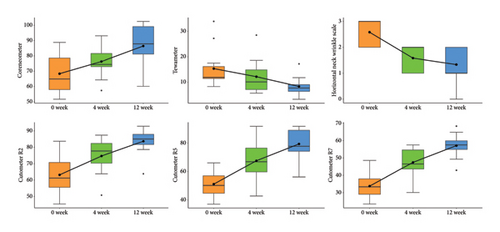
4. Safety Outcomes
Treatment-related local adverse effects such as mild-to-moderate edema and erythema occurred in all patients. The symptoms subsided in a few days after treatment. All the patients completed the study. No serious side effects were reported.
5. Discussion
The pursuit of effective neck rejuvenation methods has been a longstanding challenge in esthetic medicine due to the unique characteristics of aging observed in the neck region [13]. Traditional surgical interventions have historically been the primary approach for addressing neck laxity and skin aging [14, 15]. Surgical treatment for neck wrinkles, such as neck lifts, can lead to complications including bleeding, infection, scarring, changes in skin sensation, and dissatisfaction with results, which may sometimes necessitate revision surgery [14, 16]. However, the emergence of minimally invasive technologies, such as microneedle RF devices [17], has provided alternative options with potentially improved safety profiles and reduced downtime—chemical peeling, laser resurfacing, dermal fillers, botulinum toxin, and RF therapy. These treatments are generally well-tolerated and can provide clinical improvements with minimal downtime compared to more invasive procedures.
In this study, we evaluated the efficacy of a novel microblade RF device for nonsurgical neck rejuvenation. Our results demonstrate significant improvements in horizontal neck wrinkles, as HNWS scores improved by an average of 35%, while skin elasticity increased by 22%. The observed improvement in the HNWS score aligns with previous findings that microneedle RF devices stimulate collagen production and tighten lax skin, resulting in overall improvement in skin texture and elasticity.
Unlike laser therapy, which primarily targets superficial layers, the microblade RF device delivers controlled energy to deeper tissue, enhancing long-term collagen remodeling. While botulinum toxin and fillers provide immediate results, their effects are temporary, typically diminishing within 3–6 months without significant preventative benefits against further wrinkle formation. In contrast, microblade RF stimulates collagen remodeling, offering longer-lasting improvements in skin elasticity and structure. Additionally, by strengthening the skin’s internal support system, this technology helps to prevent further wrinkle development over time.
Recent insights have revealed that the well-known process of dermal remodeling and rejuvenation following RF stimulation [18, 19] is attributed to the removal of accumulated senescent fibroblasts, which are more susceptible to heat compared to younger cells [20]. The buildup of these dysfunctional yet living fibroblasts disrupts the synthesis of the dermal matrix and the integrity of the epidermal structure, leading to the characteristic aging of skin tissues [21]. Various RF-based devices designed to transfer heat to the dermal layer have been suggested to induce skin rejuvenation by eliminating these heat-sensitive senescent fibroblasts. In particular, the precise delineation of targets using dual-length blades, specifically targeting the papillary and reticular dermis, proves to be a successful approach for achieving comprehensive rejuvenation across all skin layers [22, 23].
The thermal injury induced by RF energy promotes the synthesis of collagen and elastin, critical components of the extracellular matrix (ECM) [24]. Increased ECM production enhances skin structural integrity and supports barrier function by reinforcing the dermal-epidermal junction [25]. The procedure also influences the expression and organization of tight junction proteins in the epidermis, such as occludin and claudins. Improved tight junctions strengthen the skin barrier, reducing TEWL and increasing skin hydration [26]. Additionally, the hydration provided by HA supports the newly formed collagen and elastin, enhancing their functionality and integration into the skin matrix. HA’s volumizing and hydrating effects can provide immediate smoothing of fine lines and wrinkles, while its support of skin hydration sustains improvements in conjunction with the RF-induced structural changes [27].
The results of this study should be interpreted in acknowledgment of some limitations. First, the sample size was small, limiting the generalizability of the results. We could not determine the possible difference according to skin types. Also, limitations of this study include the absence of a control group, potential observer bias, and a short 12-week follow-up, preventing assessment of long-term effects. Future studies should include larger sample sizes, longer follow-up durations, and direct comparisons with other minimally invasive treatments.
In conclusion, our study demonstrates the efficacy and safety of the microblade RF device for nonsurgical neck rejuvenation. Data indicated low to no downtime and high patient satisfaction. The significant improvements in horizontal neck wrinkles, as well as objective measurements of skin biophysical properties, underscore the potential of this technology as a valuable tool in the armamentarium of esthetic procedures for neck rejuvenation.
Conflicts of Interest
The authors declare no conflicts of interest.
Funding
No funding was received for this research.
Acknowledgments
This research was supported by the Chung-Ang University Research Grants in 2024.
Open Research
Data Availability Statement
The data that support the findings of this study are available on request from the corresponding author. The data are not publicly available due to privacy or ethical restrictions.



